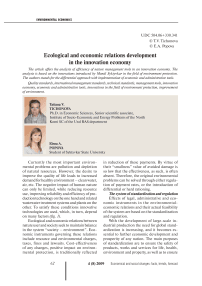Ecological and economic relations development in the innovation economy
Автор: Tichonova Tatiana Vyacheslavovna, Popova Elena Alekseevna
Журнал: Economic and Social Changes: Facts, Trends, Forecast @volnc-esc-en
Рубрика: Environmental economics
Статья в выпуске: 4 (8) т.2, 2009 года.
Бесплатный доступ
The article offers the analysis of efficiency of nature management tools in an innovation economy. The analysis is based on the innovations introduced by Mondi Syktyvkar in the field of environment protection. The authors stands for the differential approach with implementation of economic and administrative tools.
Quality standards, international management standards, technical standards, management tools, innovation economy, economic and administrative tools, innovations in the field of environment protection, improvement of environment
Короткий адрес: https://sciup.org/147223163
IDR: 147223163 | УДК: 504.06+330.341
Текст научной статьи Ecological and economic relations development in the innovation economy
Ph.D. in Economic Sciences, Senior scientific associate, Institute of Socio-Economic and Energy Problems of the North Komi SC of the Ural RAS department
Elena A.
POPOVA
Student of Syktyvkar State University
Currently the most important environmental problems are pollution and depletion of natural resources. However, the desire to improve the quality of life leads to increased demand for healthy environment – clean water, air, etc. The negative impact of human nature can only be limited, while reducing resource use, improving reliability and efficiency of production technology on the one hand and related wastewater treatment systems and plants on the other. To satisfy these conditions innovative technologies are used, which, in turn, depend on many factors (fig. 1) .
Ecological and economic relations between nature user and society seek to maintain balance in the system “society – environment”. Economic instruments governing these relations include resource and environmental charges, taxes, fines and lawsuits. Cost-effectiveness of any changes, positive impact on environmental protection, is traditionally reflected in reduction of these payments. By virtue of their “smallness” value of avoided damage is so low that the effectiveness, as such, is often absent. Therefore, the original environmental problems can be solved through either regulation of payment rates, or the introduction of differential or hard rationing.
The system ofstandardization and regulation
Effects of legal, administrative and economic instruments in the environmental-economic relations and their actual feasibility of the system are based on the standardization and regulation.
With the development of large-scale industrial production the need for global standardization is increasing, and it becomes essential to further economic development and prosperity of any nation. The main purposes of standardization are to ensure the safety of products, works and services for life, health, environment and property, as well as to ensure
Figure 1. External factors of innovations working out and introduction in the field of environment protection
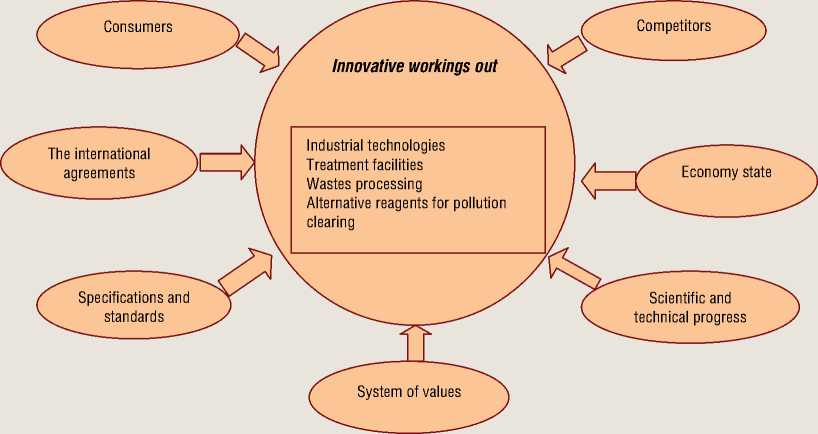
product competitiveness, product quality for consumers and the state, for the sake of saving all kinds of resources [4].
The world has a very varied practice of standards. For example, in Japan, governance arrangements are primarily focused on the development of health standards, supplemented by restrictions on emissions for individual industries and types of production. Environmental standards are developed in the so-called public negotiations between industrial firms and local authorities. In Finland, there is also no uniform system of environmental standards for emissions. Instead of it, each region has the right to negotiate with potential “polluters” and reach agreement on acceptable environmental loads. There is another kind of standards – standards of “inter-regional diffusion”, which determine the amount of pollutants rendered outside the region for a certain period of time [11].
The procedure for setting standards in Russia, as a rule, consists of detection of pollutants which are hazardous to health and welfare, establishment of allowable levels of pollution and the adoption in every region of the implementation program of the rules of regulation and determination of the level of economic opportunities for their implementation. Thus, the state is always faced with the task of inflicting such a level of regulation of environmental quality, which would permanently satisfy comfortable life support indices of environment and would be fulfilled by “potential polluters”.
In general, the system of standardization includes:
-
• quality standards;
-
• standards of Management;
-
• technical standards.
Environmental quality standards set legally binding limits on pollution or adverse impacts, which should not be exceeded in a given environment or its components. Traditional environmental quality standards are the quality standards of air and waters, noise and vibration, unpleasant smells.
The first standards of maximum permissible concentration (MPC) in Russia were established in 1939 for drinking water. Currently, the number of such standards for water utility and water facilities, cultural and domestic purposes has increased to two thousand. The first ten MPC pollutants have been introduced into practice in 1951, now there are about 500. Standards for MPC of harmful substances in the soil have been introduced since 1980, currently they are set for 109 harmful substances.
Quality standards in the United States first began to be used in the early 70-ies under the federal laws on air and water quality. In accordance with the law “About Clean Air” (1970) standards were introduced at the state level with the obligatory fixation in the activities plans and were applied to all sources of air pollution (existing and new). In 1977, amendments to this law, the standards are divided into primary and secondary ones. The former are set in the interest of public health, the latter are sufficient to protect the environment and “public welfare” from the real and potential effects of pollution [11].
Environmental Quality Standards have been also adopted in Eastern Europe, but were not observed because of lack of appropriate legislative instruments. In recent years they have been introduced in Germany, Denmark and several other Western European countries.
Currently international standards of governance gain in importance. They passed the test of time and play a positive role in enhancing the business responsibility to society for the preservation of the environment. Various organizations are increasingly interested in how to achieve adequate environmental performance and demonstrate it by controlling the impact of its activities, products or services on the environment, taking into account their own environmental policies and environmental targets. The voluntary consent of enterprises and companies to follow these agreements and standards is the recognition of the fact that domestic environmental policies can increase their incomes and improve competitiveness. In turn, the public gets into the hands a new tool for monitoring the activities of corporations, which have assumed those obligations.
The most common management standards are the ISO 14000. They are designed to provide organizations with elements of an effective environmental management system, which can be combined with other elements of the administration in order to assist organizations in achieving environmental and economic goals. ISO 14001 specifies requirements for environmental management system, i.e. the procedural part of it. It is designed in the way that it can be applied to organizations of all types and sizes taking into account the different geographical, cultural and social conditions. The success of the system depends on the commitments entered into at all levels and all parts of the organization, especially senior management. Such a system enables an organization to establish procedures (and evaluate their effectiveness), to develop their environmental policies and environmental targets, to achieve compliance with these policies and targets, and demonstrate this conformity with the others [14]. The overall goal of this standard is to support measures to protect the environment and prevent pollution while maintaining balance with socio-economic needs. It should be noted that many of the requirements can be viewed simultaneously or revised at any time. For example, in Russia, large enterprises such as JSC “Solombala PPM”, UzDEUavto, As-troSoft, Mondi SLPK are certified according to ISO 14001.
On the territory of the European Union also operates a system EMAS – voluntary regulation, a claim against the systematization of environmental work and reporting on its implementation. The basis of the standard is the principle of compensation for economic loss of environmental objects by the culprit causing this damage. The purpose of EMAS is to encourage enterprises to develop their projects to protect the environment systematically and in excess of those standards and requirements defined by national legislation of European countries. At present, environmental management system EMAS is most often used in the chemical and manufacturing industries, electricity, gas and water [13].
According to the authors, it is worth mentioning the principles of CERES. These principles are acceptable to all corporations, public organizations and private individuals. They establish the basic criteria for assessing the activities of corporations and are intended, on the one hand, to improve the environmental performance of signatory companies, on the other – allow investors to make informed decisions. Up to now the CERES Principles were signed by such major companies as Coca-Cola (USA), Polaroid, General Motors and over 40 others [1].
In recent years international management standards are playing an increasing role. Successful implementation of management standards ensures the creation of a system that provides a gradual rise in the business.
The development of science and technology, increase economic security, as well as awareness of environmental issues led to the emergence of technical standards . Technical standards are specifications for the ecological character of technology, equipment, technological processes and so on. Compliance with these standards involves the introduction of advanced treatment systems, facilities, and modern “nature friendly” technologies and equipment. The introduction of new technology is an innovative process. Reducing of resources consumption is achieved in various ways, among which we can allocate resources in a closed cycle, the implementation of recycling and reuse of resources, the use of resourcesaving equipment [12]. For example, in the production of cellulose reducing of water use can be achieved through the use of circulating water after being released from local clearing systems, the use of bleaching and washing technology at high concentrations, the reconstruction of the CMB and turbine generators.
In Sweden was found the use of the system of technical regulation. The point of reference is the level of purification of gas emissions and wastewater discharges, which allows you to get the best at the moment technology. In accordance with this basic calculation of payments is made and the company is given time to retool; if the company doesn’t meet this condition, the license is revoked [18].
Functionally standards and norms are the starting point in the formation of any economic regulatory tools of environmental-economic relations. System of hard rationing (e.g., technical regulation) always involves significant costs and is usually used in countries with high living standards. Thus, in the United States, Germany, France, where the permissible amount of emissions (discharges) is governed by technical standards, the standards are divided into two groups: those for existing technologies and in prospect for the best ones. In these countries, for the newly designed enterprises the use of standards for the best emerging technologies is necessarily. The period of use of existing technology standards are limited to three to five years before the renovation or conversion of production. For companies that have no set limit on emissions and (or) discharge standards for existing technologies, there is an administrative order requiring to rebuild, restructure them, and in some cases even directing their partial or total closure for environmental reasons. In the period of work with the exceeding of standards of existing technologies the company pays extra charges [18].
Reasonable adaptation of national standards to international experience will not only help integrate Russia into the international community, but also would improve the current system of rationing in the field of environmental protection.
Experience of environmental management instruments use
The main objective of innovation in the field of environmental protection is to reduce emissions and discharges of pollutants to a level not exceeding the assimilative capacity of the environment. Theoretically, if the amount of pollutants entering the environment does not exceed the maximum allowable value (VAT and MPD within the normative values), this natural system itself, without additional cost, copes with the coming into it pollutants and neutralizes them without any significant consequences for themselves [16]. At present, environmental management system includes the following methods of control: legislative and information, economic and administrative (fig. 2) . These methods can be divided into components, each of which affects the formation of domestic environmental policies of the enterprise and impacts on its economy.
Typically, the state's role is to regulate and control through legislative and administrative measures: laws, decrees, orders and procedures, regulation and standardization, on the one hand, and the monitoring, audit and examination on the other. The certification and licensing processes have allowing functions [17]. International conventions and agreements have the importance in legislative and information management. Thus, governments that have ratified the Kyoto Protocol, oblige companies to cut emissions of greenhouse gases, by applying the domestic legislative and administrative measures.
Economic tools involve the introduction of payments for negative impact on the environment, taxes, penalties and subsidies, soft loans and other economic incentives to interest producers and consumers in environmental management. This shows that economic instruments in Russia are largely coercive in nature.
In Western countries and the United States the role of economic instruments is to create mechanisms that promote the activities of the preservation and seeking to minimize the economic costs incurred to society in order to achieve the desired state of the environment and its individual components. Such an incentive system of the introduction of advanced technologies ecotechnics and environmental management includes tax rebates and exemptions, subsidies, both at the state level and at the enterprise level, low-interest loans (fig. 3).
Almost all of the tools for promoting environmental management are used in the case of the introduction of elements of improving environmental technology decontamination.
Tax credits are available on sales of ecotechnics in Germany, France, Japan and the United States. Tax incentives for accelerated depreciation of pollution control equipment are allocated with different fractions of a percent (22 – 100%) in Canada, Austria, Germany, France and Japan [10].
The practice of subsidies is very diverse. For example, in the US government subsidies to municipalities and private businesses to improve and expand water treatment facilities are issued within 5 years. Moreover, the amounts vary during the period from 90% in the first year to 0% in the last.
Figure 2. Wildlife management influence levers
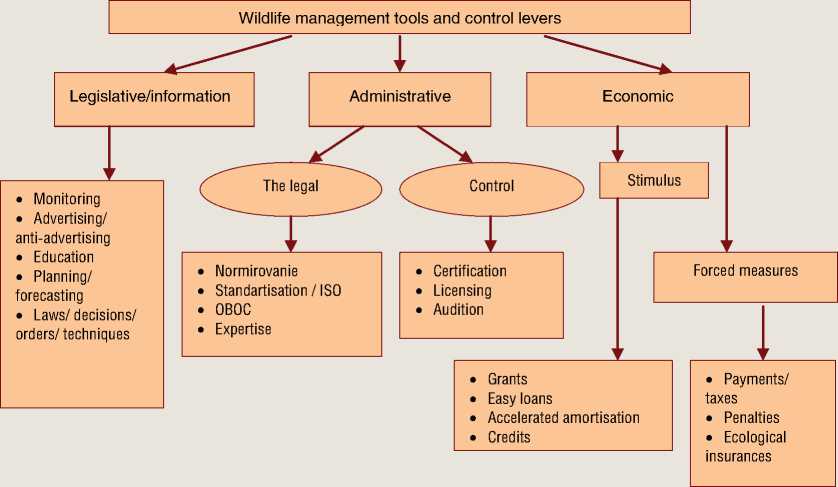
Figure 3. Foreign experience of rational wildlife management stimulation tools use
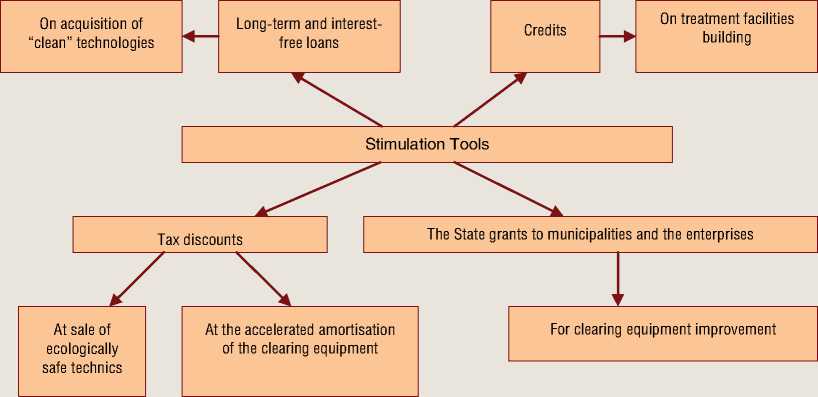
In Japan lax credits are issued to small and medium-sized enterprises for the construction of treatment facilities and the purchase of environmental equipment at 80% of their value. Maturity date is 10 – 12 years at interest rates below market rates – from 5 to 7% per annum [2, 3].
In the United States became widespread a system of interest-free loans for the purchase of “clean” technologies. Through the provision of loans by investment banks on average 40% of the exports of such equipment for the needs of industry are funded annually, and the State guarantees the timely repayment itself [7].
In addition, to assist small businesses in environmental protection, government organizations and commercial banks on the basis of state guarantees issue long-term loans (up to 30 years) at low interest (6.65%) within 500 thousand dollars [9 ].
There are techniques specifically designed for the disposal of waste. Initially, the company acquires the right to their location, and after utilization spent the money back. Thus, the temporary disposal of waste is free for the “polluter” and part of the pollution rights is bought back from him [5].
Positives of use of economic instruments in foreign countries in the pay nature system and environmental protection are as follows:
-
• the use of mechanisms to regulate environmental-economic relations, based on quantitative and qualitative characteristics of fulfillment of standards; fees and taxes specifically used to fund environmental work, licensing and subsidies;
-
• a combination of various methods of promoting the rational use of natural resources and environmental protection, such as tax abatements, subsidies, indefinite loans, tax incentives and credits, etc., provided only for improving environmental technology;
-
• organization of special financial structures of the environmental focus.
Factors improving the ecological condition
Differentiated approach to calculating rates of payment is very high. Thus, during the past year the Government of Russia has discussed a draft proposed by Natural Resources Ministry on the implementation of measures in the light of the new concept of environmental protection. These measures included the amount of payments and the conditions of their collection. A significant increase in payments in the event of failure of these regulations is possible, at the same time for enterprises applying advanced environmental technologies, payments can be minimized or canceled [8].
Reduction of natural resources consumption and negative impacts on the environment can be achieved through economic and administrative measures. For example, several countries banned sale of products produced on obsolete technologies, and companies which do not improve manufacturing technology, lose market share sales, leading to a reduction in sales and hence earnings of an enterprise [6]. At the same time, companies operating on obsolete equipment, can not produce high quality production and in large volumes, so they are not promising for investors and their access to loan capital reduces, which in the long term can lead to a shortfall in the budget of the enterprise. In addition, depreciation of equipment and treatment facilities, a high probability of accidents will increase the rates for insurance. Thus, there is the interdependence of ecological and economic aspects of the enterprise.
The situation is similar for administrative measures of environmental management. Certification according to international standard brings the company the following benefits:
-
• improved reputation and market share;
-
• criteria settlement of the investor and greater access to capital;
-
• obtaining of insurance at low rates;
-
• creating of a favorable image of the company in the eyes of consumers, government agencies and the public.
At the same time, production companies, not certified by international standards, is uncompetitive compared to similar products by the certified company.
Analysis of administrative (rationing system in the EP) and economic (environmental and resource payments) tool impacts, affecting the implementation of innovative development, showed the following (fig. 4) :
Figure 4. The block-diagramme of the ecological condition improvement achievement mechanism
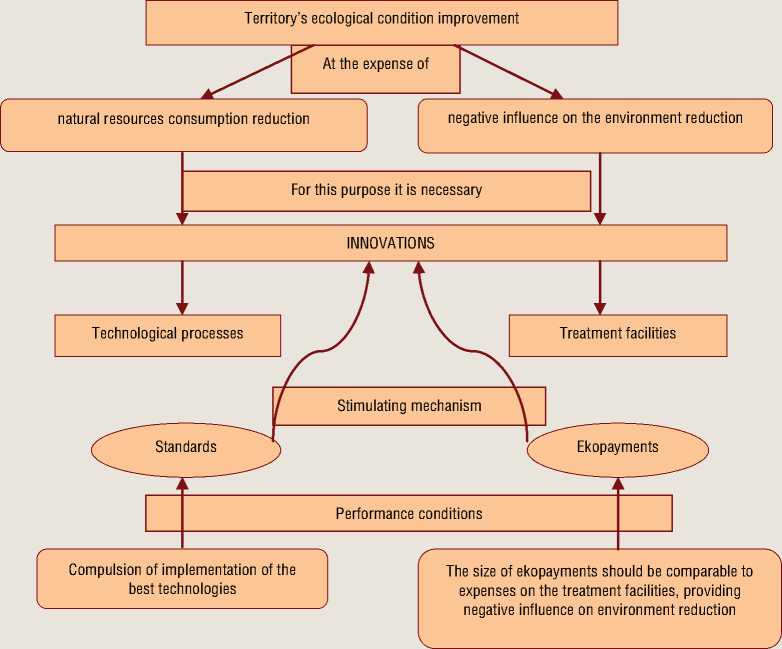
-
1. Innovations, having a positive impact on environmental protection, is related to upgrading purification plants themselves and technological processes.
-
2. Upgrading of sewage treatment plants is aimed at cleaning efficiency of pollutants and concerns changes of cleaning agents, sewage treatment plants, etc.
-
3. Improvement of technological processes is aimed at optimal use of resources (usually water) and the use of alternative components (for example, the use of chlorine dioxide instead of pure chlorine in the cleaning of cellulose), etc.
-
4. Environmental standards governing the state of environmental protection, fall into the quality standards of environmental protection, international management standards of ISO and technical standardization.
-
5. Formation of stimulating economic factors through environmental fees (i.e., increase ekopayments to achieve the most favorable ecological condition of the environment) is based on the implementation of quality standards of environmental protection by bringing the size of these payments to a level commensurate with the upgrading of sewage treatment plants.
-
6. Implementation of environmental technical standards (elements of technical and procedural standards) stimulates innovation processes of production, leading ultimately to improving of the environmental situation.
In summary, it should be noted that the administrative methods of environmental management are now playing a greater role than economic ones. Investment of companies in upgrading technologies, introduction of advanced sewage treatment plants, upgrading of equipment are many times greater than the amounts paid to their environmental charges. Nevertheless, the company are ready to invest heavily in environmental protection to meet international technical standards and management standards for the formation of a favorable environmental profile and improve the competitiveness of their products.
An example of the introduction of innovative developments in the field of environmental protection in the enterprise “Mondi Group Syktyvkar”.
“Mondi SFC”, one of the largest enterprises of pulp and paper industry in Russia, is the main pollutant of water, air and soil in the city of Syktyvkar. The company has a negative impact on the health of the population of adjacent residential areas.
According to results of socio-hygienic monitoring of the Komi Republic, the impact of adverse environmental factors on the health of the urban population makes 20 to 30% of diseases in the general structure of pathologies. Mondi Group Syktyvkar is located 30 kilometers from the city of Syktyvkar in the town Ezhva. Currently, pollutants from the activities of the enterprise have a significant impact on human health, especially at the level of ecological morbidity (fig. 5) . Levels of respiratory diseases in Syktyvkar and Ezhva have significant differences, which are explained by the influence of the timber-processing complex.
Affiliation of Syktyvkar timber-processing complex to transnational corporation Mondi defines the company's commitment to meet international standards. During 2004 the company has been actively pursued in preparation for certification under ISO 14001, developed environmental policy, and in the end of the year, the auditors of the Austrian company OQS Certifikation and Evalution Ltd. had issued a certificate confirming compliance with existing environmental management systems to international standards.
Compliance of company “Mondi Group Syktyvkar” to international environmental standard ISO 14001 enabled:
-
- to sell their products in EU countries at a higher price than the companies which are not certified to environmental standards;
-
- to borrow on favorable terms;
-
- take out insurance at minimal rates.
Business investment in environmental protection include environmental payments and the cost of upgrading production technology,
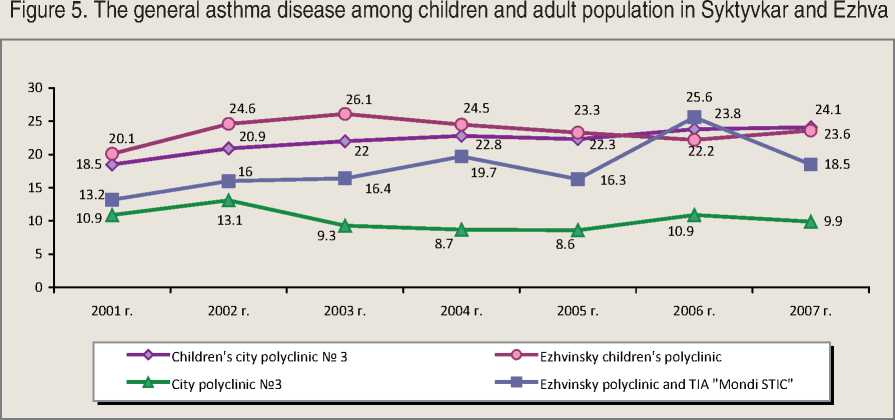
introduction of improved, more reliable equipment, introduction of new treatment systems, the production of “environmentally friendly” products as well. It is known that the amount of environmental charges is disproportionately small compared with the total investment of conservation value. For example, for the period from 2003 to 2006, environmental fees of “Mondi Group Syktyvkar” amounted to only 5% of all investments of the enterprise in environment.
One of the largest projects the company was the transition to the bleaching of pulp without the use of elemental chlorine (ECF-bleaching). Modernization of the company associated with the replacement of equipment for the introduction of this technology began in 1999. During 1999 – 2006 investment of enterprise in environmental protection amounted to 2.6 billion rubles, including 965 million rubles investment in the project of bleaching on the technology. Effectiveness of innovative technology is reflected in income from three components: economic, environmental and social.
The effectiveness of environmental protection, usually expressed in the reduction of pollution and the consequent reduction of environmental fees, and ultimately to the recession of ecological morbidity (respiratory, endocrine and nervous systems). The volume of prevented damage by reducing harm- ful emissions (methylmercaptan, hydrogen sulfide, sulfur dioxide, inorganic dust, carbon monoxide, etc.), discharges (formaldehyde, nitrites, phosphates, etc.) and formation of waste wood (knots) for 1999 – 2006 was about 30 million rubles. Thus, there is the apparent incompatibility of the costs of enterprises for environmental protection and the economic effects of environmental protection activities (2.6 billion rubles and 30 million rubles respectively). Despite a slight economic benefit, the most important, according to the authors, is the fact that thanks to this technology, the volume of hazardous emissions is established within the normative values, which means they are the lowest for these production volumes. If the volume of discarded or discharged hazardous substances is within the normative values, theoretically, this means that the environment is able to assimilate this pollution.
Positive results of environmental activities Mondi Group Syktyvkar is a sharp reduction of chlorine and organochlorine compounds in the emissions (2.5 times), decrease of concentrations of organochlorine compounds in wastewater (5.5 times), which reduces the possibility of cancer, respiratory and the nervous system diseases of the inhabitants of the adjacent residential areas. Due to the fact that chlorine is a volatile compound, in the case of an emergency, i.e. when it spills, it quickly spreads to large areas. Lack of elemental chlorine in the enterprise leads to the exclusion of the probability of poisoning population by chlorine [15].
Social efficiency is expressed by the following results:
-
1. Reducing the possibility of cancer, respiratory and the nervous system diseases of the inhabitants of the adjacent residential areas due to the reduction of chlorine and organochlorine compounds in the emissions and discharges of the enterprise.
-
2. Reducing environmental risk and occurrence of accidents.
-
3. Providing local employment during construction and installation of equipment.
Thus, for the first time in the Republic the compliance of environmental regulations was the impetus of technical innovation in the field of wood processing. The introduction of the practice in addition to quantitative (MPC, MPD, MPE, etc.) procedural standards – certification and ISO, requirements for adherence to the use of “clean technologies” was now more effective for the environment than a set of tools on the principle “polluter – pays” – of the resource and environmental charges.
Total cost of office and offset paper, produced by "Mondi Group Syktyvkar", thanks to recent innovations in Russia market grew by 3 – 5% in the CIS and developing countries. Environmental standards adopted in EU countries prohibited sale of paper, bleached with using of elemental chlorine, i.e. containing organochlorine compounds. The use of ECF-bleaching allowed the company to sell its products in the markets of EU countries, where the price is above its average of 7%.
Thus, the transition of “Mondi Group Syktyvkar” on the ECF-bleaching increased the competitiveness of its products, expanded market share and allowed to sell products at higher prices. All this led to an increase in revenue of the enterprise.
From the introduction of new bleaching technology Mondi Group Syktyvkar in addition to the direct benefits – increased revenue – has an indirect economic benefit, which is the in- crease of investors’ and insurers’ confidence, and thus the access to capital is expanding and the interest rates for insurance are minimizing.
In summary, we can note the key points of environmental-economic relations and measures to improve them:
-
1. The negative impact of human nature can be limited by reducing the consumption of natural resources and improving the reliability and efficiency of production technology and related wastewater treatment systems and facilities. Implementation of these conditions determines the introduction of innovative technologies.
-
2. Effects of legal, administrative and economic instruments in the environmental-economic relations and their actual feasibility are based on the standardization system, rationing, and limitation. Using of strict measures of technical regulation is typical for countries with high living standards.
-
3. The position of the company's management, its environmental policies have played a greater role than the “economic leverage”, so what is becoming particularly urgent is introduction of the standards of ISO and EMAS.
-
4. Overseas experience in the use of regulatory instruments of environmental-economic relations differ in combinations of various methods of promoting the rational use of natural resources and environmental protection, such as tax abatements, subsidies, indefinite loans, tax incentives and credits, used primarily in the case of the introduction of innovative environmental technology.
-
5. A differentiated approach needs to be introduced with the use of economic and administrative measures and instruments to promote environmental management in enterprises.
-
6. The introduction of effective economic incentives is required from the part of the state to reduce the negative impact of business on the environment.
Implementation of these measures in the field of environmental protection will optimize financial and economic costs of environmental regulation and improve the ecological situation in general as well.
Список литературы Ecological and economic relations development in the innovation economy
- Hunter, D. International environmental law and policy/D. Hunter, J. Salzman, D. Zaelke//Foundation press. -New York. -1998. -P. 1385-1416. (Shorter translation made by Sergei Solyanik).
- Jacobs, M. The green economy/M. Jacobs//Plyto Press. -1991. -69 p.
- Opschoor, J. Economic instruments for environmental protection/J. Opschoor, V. Hans//OECD. -1989. -12 p.
- Askarov, E.S. The essence of modern standards: Business guide/E.S. Askarov . -Mode of access: http://www.bonsk.ru/articles.php?cat_id=59&id=304
- Golub, A.A. Environmental management in transition economy/A.A. Golub, E.B. Strukova//Problems of economics. -1995. -№ 2. -P. 139-149.
- Golub, A.A. Economic methods of environmental management)/A.A. Golub, E.B. Strukova. -Moscow: Nauka, 1993.
- Demakova, V.D. Economic instruments for environmental protection in the region/V.D. Demakova//Vestnik of SSU: ser. 6. -Vol. 1. -1995. -P. 4-14.
- Kuvshinova, O. Flexible rates/O. Kuvshinova//Vedomosti. -2008. -№ 46 (2068).
- Maglakelidze, T. Environmental security: the relationship and impact on economic growth/T. Maglakelidze//The Economist. -2002. -№ 6. -P. 83-87.
- Malikova, O.I. Environmental management in the Federal Republic of Germany/O.I. Malikova//Vestnik MGU: ser. 6. Economy. -2001. -№ 1. -P. 71-82.
- Environmental protection in the united states. Science and national programs. -M., 1990.
- Semerikov, V. Will the progress be in standard and technical regulation?/V. Semerikov//Standards and quality. -2007. -№ 7.
- Certification to EMAS . -Mode of access: http://www.itsu.ru/news-archiv-open/52-19-07-12-2007_sertifikaciya_po_sisteme_EMAS
- Standard in the field of environmental protection ISO 14001, 1999.
- Step: Step into the future/Mondi SFC, 2008.
- Tichonova, T.V. Regulation of environmental costs -the new point of reference/T.V. Tichonova//Ecology of industrial production. -2008. -№ 1. -P. 8-11.
- Tichonova, T.V. The levers of controlling the financing of environmental activities/T.V. Tichonova//Economy of North-West: challenges and prospects. -2008. -№ 2 (32). -P. 15-20.
- Shirobokov, A.S. Legal foundation of establishment and application of limits for emissions and discharges of pollutants and microorganisms/А.S. Shirobokov//The Jurist. -2006. -№ 2.

